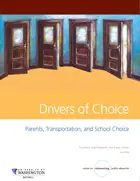Transportation is clearly a consideration to be factored into any discussion of school choice. Yet we know very little about how much it matters in family’s decisions about their children’s school, and almost nothing about how much of a barrier it is to school choice, especially for low-income families. How far does the average family want their child to travel to school? Would they be as comfortable letting their younger children travel as far as they might a middle or high school student? What transportation options are available to low-income families? These are the kinds of questions we tried to address in this study, in order to obtain meaningful data to help shape school transportation policy.
This project first surveyed the landscape of transportation and school choices. It examined the density of large districts in the U.S. The project team contacted large school districts to find out their policies on transportation and choice, then examined district budgets to see how much they actually spend on transportation. Most importantly, the project surveyed families in two cities—Denver and Washington, D.C.—to find out their travel patterns and school choice options. The study breaks down that data, collected from households earning less than $75,000 in annual income, to determine how much transportation is a barrier to choice.






